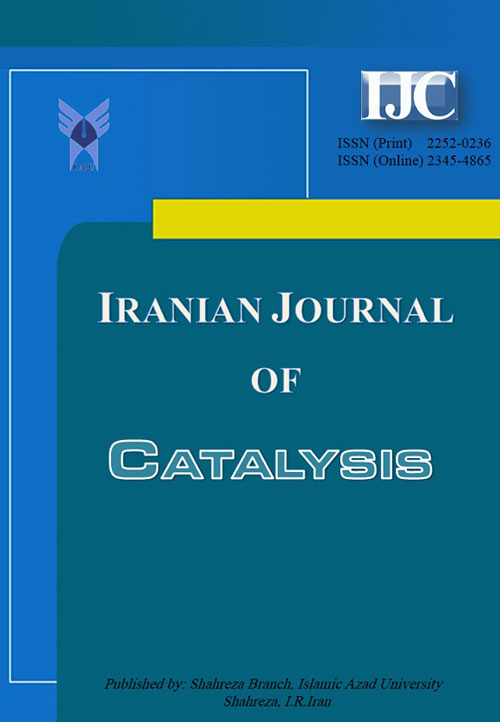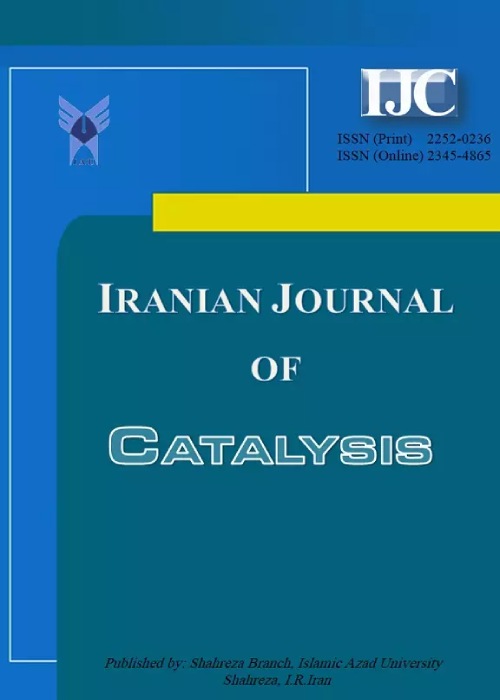فهرست مطالب

Iranian Journal of Catalysis
Volume:12 Issue: 1, Winter 2022
- تاریخ انتشار: 1400/12/10
- تعداد عناوین: 10
-
-
Pages 1-11Green synthesis of cupric oxide nanoparticles (CuO NPs) has been promoted as an environmentally-friendly, cost-effective and high yield method. The CuO NPs have been synthesized by reducing copper sulphate using an aqueous flower extract of Clitoria ternatea. The UV-visible peak observed at 251 nm confirmed the formation of CuO NPs. The optical bandgap energy value of CuO NPs was found to be 2.16 eV. The presence of Cu-O band at 490 cm−1 in the FTIR spectrum confirms the formation of the CuO NPs. The XRD exhibits monoclinic structure with an average crystallite size of 17.46 nm. The negative zeta potential value (-17.7 mV) demonstrated the stability of CuO NPs. The formation of agglomerated and roughly spherical NPS was shown by FESEM images. As seen in the HRTEM images, the nanostructure appears to be aggregated CuO NPs, and the average size of the particle was found to be 18 nm that matched with the XRD analysis. The EDX analysis showed presence of Cu (96.19%) and O (3.81%) in the spectrum. The CuO NPs exhibit significant antibacterial activity against Gram +Ve Staphylococcus aureus and Gram –Ve Escherichia coli bacteria. Finally, the synthesized CuO nanostructures demonstrate the photocatalytic degradation of Direct Red (DR) and Crystal Violet (CV) dyes under sunlight. The efficiency of degradation within 150 min was determined to be 65% and 88.3%, respectively for DR and CV. This effective removal method under sunlight may support a cost-effective method for degradation of DR and CV dyes from wastewater.Keywords: Green synthesis, Clitoria ternatea, CuO NPs, Antibacterial-activity, photocatalytic dye degradation
-
Pages 13-24A novel organic-inorganic hybrid magnetic nanomaterial, namely nano-[Fe3O4@SiO2@R-NMe2][FeCl4] (nano-[FSRN][FeCl4]) was prepared, and characterized by EDX, elemental mapping, FE-SEM, FT-IR, XRD, VSM, TG and DTG analyses. Then, it was applied as a highly efficient and magnetically recyclable catalyst for the solvent-free synthesis of bis-coumarins from 4-hydroxycoumarin (2 eq.) and arylaldehydes (1 eq.). NMe2 is a basic group, and FeCl4− is a Lewis acid; thus, nano-[FSRN][FeCl4] can act as a dual-functional catalyst; based on this and the literature, a plausible mechanism was proposed for the reaction.Keywords: Organic-inorganic hybrid magnetic nanomaterial, Nano-[Fe3O4@SiO2@R-NMe2][FeCl4] (nano-[FSRN][FeCl4]), Dual-functional catalyst, Bis-coumarin, Solvent-free
-
Pages 25-44ZnO nano particles and Cu modified ZnO nano composites have been prepared by simple, facile hydrothermal approach. The novelty of this work was the use of aqueous methanolic solution (50:50 ratio) as the solvent of reaction, while zinc chloride was used as the precursor of ZnO NPs and Cu- modified ZnO nano composites. XRD results revealed that the synthesized ZnO and Cu-modified ZnO nano composites were of nano size and XRD patterns matched with JCPDS Card 35-1451, confirming the synthesis of ZnO nanoparticles. The FT-IR results confirmed the synthesis of target materials and also the adsorption of Cu metal on ZnO surface. The UV visible spectroscopic analysis indicated that the optical properties improved as the concentration of Cu metal increased on ZnO surface. SEM analysis explored the spherical shape of synthesized nano composites. The EDX graph showed the elemental composition of prepared materials that composed of Zn, O and Cu and no other impurity was found. The Tartrazine Yellow Azo Dye was degraded to investigate the photo catalytic activity which was optimized under sunlight with increasing the Cu metal concentration on surface of ZnO.Keywords: ZnO Nano Composites, Cu Modification, Hydrothermal, Photo catalysis, Dye removal, Tartrazine Yellow
-
Pages 45-53Synthesis of organic compounds using some natural compounds as catalysts has gained more attention in recent decades. With respect to the importance of these procedures, the synthesis of 3,4-dihydropyrano[2,3-c]chromene and pyrano[2,3-d]pyrimidine derivatives using vitamin B12 by a one-pot reaction of malononitrile, benzaldehydes and 4-hydroxycumarine or 1,3-dimethylbarbituric acid is reported.Keywords: Vitamin B12, Aldehydes, Pyrano[2, 3-c]chromene, Pyrano[2, 3-d]pyrimidine, Biocatalyst, Green route
-
Pages 55-68The oxidation process of benzylic halides especially benzylic bromide to corresponding carbonyl compounds such as aldehydes and ketones is a worthwhile and important organic reaction in industrial and laboratory synthetic organic chemistry. In the present study, an efficient and novel method to obtain carbonyl compounds using benzyl bromide with a catalytic amount of chromium complexes in water under aerobic conditions was reported. The six types of chromium complexes were prepared via the reaction mixture of four ligands. The prepared ligands and chromium complexes were characterized using Fourier transform spectroscopy (FT-IR), elemental analysis, molar conductivity, and magnetic moment, as well as UV-Vis spectroscopy. Different benzyl bromide derivatives were selected with both electron-donating groups and electron-withdrawing groups at –ortho, -meta, and –para positions. Under the optimum conditions, the corresponding benzaldehyde derivatives were obtained in moderate to excellent yields. In addition, the biological activity of the prepared chromium complexes was checked.Keywords: Carbonyl compound, Chromium complex, Oxidation, Synthesis, Biological activity
-
Pages 69-76
An efficient electrocatalyst was developed based on silver nanoparticles/multi walled carbon nanotubes nanocomposite modified glassy carbon electrode (AgNPs/MWCNTs/GCE) by controlled electrodeposition and continuous double-potential pulses to test the high explosive cyclotetramethylene-tetranitramine (HMX) using cyclic voltammetry method. The electrochemical behavior of the system in various pHs was studied by cyclic voltammetry (CV), electrochemical impedance spectroscopy (EIS), chronoamperometry and chronocoulometry; and some reduction parameters, including the transfer coefficient (α), electron transfer number, apparent electron transfer rate, and diffusion coefficient constants of HMX were estimated. The results demonstrated that reduction of HMX by adsorptive stripping voltammetry on AgNPs/MWCNTs film could remarkably be enhanced and catalyzed compared to bare carbon nanotubes electrode, and the reduction potential could be facilitated from -0.7 V (vs. SCE) to -0.3 V, with electron exchange rate constant of 1.12±0.1 s-1 and 0.17 ±0.1 s-1 for AgNPs/MWCNTs and bare MWCNTs electrodes. Chronoamperometry studies showed a diffusion-controlled process with an apparent diffusion coefficient of 2.01×10−4 cm2 s−1 and a catalytic rate constant of 7.48 times higher than that of bare MWCNTs electrode. Also, chronocoulometric studies showed that the number of electrons transferred for electrochemical reduction of HMX was near 1.98. Under optimized conditions, the reduction peak had two linear dynamic ranges of 2.0-30.0 and 30.0-120.0 mM with the experimental detection limit of 0.2 mM and precision of <2.5% (RSD for five analyses). This modified electrode can be properly used to determine HMX in soil and groundwater samples with satisfactory results.
Keywords: HMX Explosive, Carbon nanotubes, Ag Nanoparticles, Voltammetry, Determination -
Pages 77-84
In this study, a simple technique was used for synthesizing one-dimensional ZnO/Fe2O3/Fe3O4 nanostructures (NSs) through heat treatment under vacuum by using a magnetic field at a temperature of 200 °C for 1 h. The photocatalytic effect of the NSs were studied by decomposing methyl orange (MO) dye (5 mg/L, pH = 8.1) under ultraviolet illumination. The experimental results indicated that a 33-mg/L ZnO/Fe2O3/Fe3O4 NS-containing film on glass could reduce the MO concentration by 37% in 100 min, and the synthesized ZnO/Fe2O3/Fe3O4 NS-containing films could be reused to degrade MO solution. Moreover, 0.1 g/L of ZnO/Fe2O3/Fe3O4 NS-containing powder exhibited an excellent photocatalytic effect and reduced the MO concentration by almost 90% in 100 min.
Keywords: ZnO, Fe2O3, Fe3O4 nanostructures, Heat treatment in vacuum, magnetic field, Photocatalyst -
Pages 85-95Cuprous oxide nanocubes (Cu2O NCBs) were successfully functionalized with graphene quantum dots (GQDs) to form GQDs/Cu2O NCBs composites material with highly plasmonic property and photocatalytic activity. Herein, GQDs were synthesized by a hydrothermal method at 190°C for 8 h using natural sources of wheat flour and ascorbic acid as precursors and reducing agents, respectively. Cu2O NCBs were prepared via a simple chemical reduction method at room temperature. GQDs/Cu2O NCBs composites were fabricated by the simple mixing of the two corresponding component dispersions. Characterized by ultraviolet-visible spectroscopy (UV-Vis), Fourier transform infrared spectroscopy (FTIR), X-ray diffractometry (XRD), transmission electron microscopy (TEM), and energy-dispersive X-ray spectroscopy (EDX), the GQDs/Cu2O NCBs structures were confirmed. The composites possessed cubic shape of Cu2O and spherical shape of GQDs with average particle sizes respectively being ~70-80 nm, and ~3-8 nm; and an elemental composition of C (41.53%), O (47.03%), N (0.24%), and Cu (11.20%). Moreover, experiments on the methylene blue (MB) degradation demonstrated that the GQDs/Cu2O NCBs composites significantly degraded >98% of the total dye amount within 30 min. In summary, the novel composites possessed potential high catalytic activity and could be utilized as photocatalysts in the treatment of organic pollutants and biological waste such as dyes, antibiotics, and pesticides.Keywords: Graphene quantum dots (GQDs), Cuprous oxide nanocubes (Cu2O NCBs), Photocatalytic Activity, Wheat flour, Methylene Blue (MB)
-
Pages 97-106One of the foremost inescapable impediments that industrial sectors face is to remove organic pollutants, which affected nature and threatened the existence of species per se. Nanoscale magnetic ferrites are considerable materials for removing the majority of organic dyes due to their unique properties and high potential photocatalytic activity. Their photocatalytic performance in semiconductor nanocrystals has also received many enthusiasts over the last couple of years. Changing nanoferrites’ architectural building blocks and increasing their bandgap energy may improve their photocatalytic peculiarities. In the present investigation, we have studied nanoscale magnetic ferrites with Co0.4Mg0.4Cu0.2Fe1.9Cr0.1O4, (CMCFO-Crx, x= 0.1) formula. CMCFO-Crx has synthesized via sol- gel approach. The synthesized nanoparticles were characterized by XRD, SEM, UV-vis analysis, and magnetic measurement, revealing the cubic spinel structure with space group Fd-3m (N° 277), average size between 20 and 60 nm, higher bandgap energy and saturation magnetization (446 emu/g) in the presence of transition metals. The results demonstrated in CMCFO-Crx (x=0.1) compound, the Curie temperature decreases to 446 K by the substitution of Fe3+ by Cr3+ ions. The synthesized powder nanoferrites efficiently degraded the Congo Red (CR) dye (84 %) under UV irradiation, for which the most probable degradation pathway is proposed. The recyclability test exhibited the nanoscale magnetic ferrites catalysts are sensibly efficient, stable, and facile recoverable by an external magnet. Thus, the CMCFO-Crx compounds can be an applicable catalyst in wastewater treatment.Keywords: Nanoferrites, Characterization, Magnetic Measurement, Photocatalytic Degradation, Congo Red (CR) dye
-
Pages 107-113Milad Mohammadi Rasooll was born in Hamedan, Iran in 1995. He received his B.Sc. in pure Chemistry (2018) from Bu-Ali Sina University, Iran. He is pursuing a M.Sc. in Organic Chemistry under the supervision of Prof. Mohammad Ali Zolfigol. His research interest is the synthesis, characterization and applications of homogeneous and heterogeneous reagents and catalysts in organic synthesis.Keywords: Phosphorus acid, catalyst, SBA-15, Solid acid catalyst


